If you are an extra in a movie, providing background audience noise, you are supposed to murmur rhubarb, rhubarb, rhubarb. I don’t know where this idea originated or why rhubarb (why not cabbage, cabbage, cabbage for example!). Sometimes ‘peas and carrots’ are substituted but I do know that in Asterix the crowd always murmurs rhubarb, rhubarb, rhubarb.
Right now in gardens in Southern Australia the rhubarb clumps are thriving and many families are harvesting big bunches of stems and turning them into stewed fruit, crumbles and cakes. I have just found a new rhubarb cake recipe, it came from my sister via her friend’s grandmother and it is delicious (see the end of the article for the recipe). So, although now is not the time to plant rhubarb it is the time to harvest it and eat it. If you don’t have any, check our your neighbours’ gardens and later in the year (late winter) see if they will divide their clump and give you a piece.
Instructions for planting, growing and harvesting follow.
Delicious, old-fashioned rhubarb, Rheum x cultorum, is making a comeback in the garden and on the menu. While its stems are used in mainly sweet but also savory dishes, botanically it is classed as a vegetable. Although in 1947 an American court declared that it was a fruit for the purposes of taxation. The Greeks saw it as food for barbarians while the Chinese revered it for its medicinal uses. During the 1600s in England it was worth more than double the price of opium.
Seed or crowns Rhubarb can be grown from crowns or seed, but seed grown plants are very variable in colour and size, so for home gardeners it is really best to purchase a crown or potted plant with good stem colour. Plant crowns or divided clumps from late winter to early spring and harvest 12-18 months later. Seed to harvest is 3 years.There are named varieties of rhubarb with different varieties in different states, they include ‘Victoria’, ‘Sydney Crimson’, ‘Wandin Red’, ‘Silvan Giant’ and ‘Ever Red’. Alternatively, if you are lucky you may have a friend or neighbour with a good sized plant they are willing to divide. This way you will know you are getting a plant with good flavour and colour.
Position and planting Rhubarb grows best in cool and temperate regions with good rainfall. It can be grown in the sub-tropics in cooler, elevated regions but is really not suitable for the coastal sub-tropics or the tropics. Rhubarb needs good drainage, as it doesn’t like to be very wet, but equally it needs plenty of water in hot dry weather. It likes sun, but I’ve found it does best in my temperate garden where it gets morning sun and afternoon shade. Rhubarb plants prefer a slightly acid soil (5.5-6.5) and are heavy feeders so before planting, dig compost, manure and blood and bone into the soil, water well and leave for a week or so. Plant crowns or young plants about 90 cm apart, from May to October. The average family will need only one or two plants. Just cover crowns with a thin layer of soil and firmly press them into place. Water in well and mulch with compost, lucerne or pea straw. Keep mulch away from the actual crown to discourage rot.
Growing and harvesting Once a month during the growing season, water with seaweed extract and some liquid fish emulsion; this encourages stem formation. It is almost impossible to over-feed rhubarb. Cut out any flower stems that develop and pick stems very lightly in the first year. Never harvest more than half the clump at any one time, removing the outside stems first. To pick, hold the stalk near the base and pull out from the plant. This makes sure that the whole stem comes away and doesn’t leave a stump, which could cause rotting as it breaks down. Remove the leaves from the stalks. These leaves are poisonous (very high in oxalic acid), so don’t eat or feed them to poultry or other stock, but they are safe to add to the compost.
Dividing clumps Dig up and divide clumps every 4-5 years, preferably in winter. Use a fork or spade and dig the whole clump from the soil. Shake off excess dirt and with a knife or sharp spade divide the clump into large pieces, each with two or three growing points and good roots. Replant into well-prepared soil, in a different position from the original.
Stem colour Stem colour is very variable, even from named varieties. The reddest colours are produced during cold weather, the optimum being 10°C. Temperatures above 25°C slow growth and suppress reddening of the stalks. Even with temperature variability, if you have green-stemmed rhubarb, you won’t be able to make it red. Green rhubarb can still be very flavoursome, but if you want red rhubarb you will need to buy a new plant.
Pests and diseases Rhubarb does not have many pest or disease problems in cool and temperate regions. Keep an eye out for aphids, grubs, slugs and snails. Plants may occasionally be affected by downy mildew, rust and leaf spot. These can be prevented by watering only in the morning and at ground level, by removing affected parts, and spraying with an organic fungicide. In warmer, more humid regions crown rot can be a problem. This causes the whole plant to collapse. Really good drainage is essential. Remove and dispose of affected plants (not in the compost). Replant into a new position.
Use Rhubarb stems are used mainly in sweet dishes. I love it simply stewed with sugar and a little nutmeg. But it is also made into jams, jellies, sauces and pie filling. It is rich in potassium, calcium and vitamins A, C and K. In Poland it is added, with spices, to potatoes, while Afghans add it to spinach and in Italy, it is distilled to make the low-alcohol drink, rabarbaro.
Win’s rhubarb cake
2 eggs
50gms butter (melted)
250 to 350gms of brown sugar (depends how sweet you want it!)
2 full cups self raising flour
250ml of plain yoghurt or sour cream
1 teaspoon of cinnamon
500gms of roughly chopped raw rhubarb stems ( do not use pre-cooked rhubarb)
Grease a round, square or loaf tin, line the base with baking paper.
Mix all ingredients thoroughly with wooden spoon (it is hard work as it is quite a thick mixture) – add the rhubarb to the mix last and stir through.
Put mix into greased tin
Bake in moderate oven for approximately 1 hour (check after 30mins or so and turn it around in the oven) or until it springs back when touched and browned off on top. You can sprinkle more cinnamon on the top while it is cooling if you wish.
This is a moist consistency, slightly sharp and not too sweet cake. Eat on its own or serve with cream, ice cream, custard ..
Store in the refrigerator as it has yoghurt/sour cream in it.

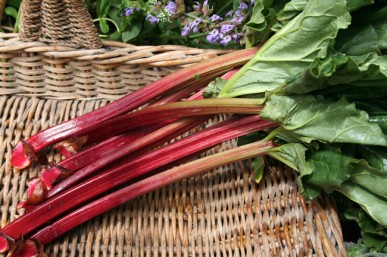
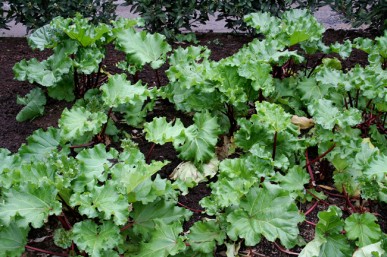
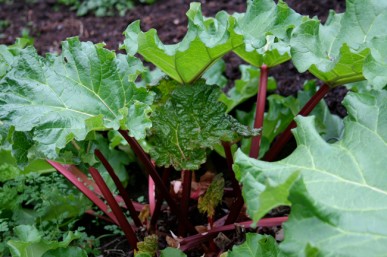
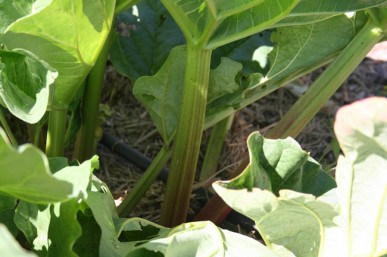
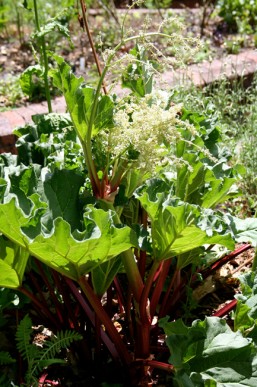
3 Comments
Dear Penny,
Have just printed out Win’s recipe for rhubarb cake. It looks delicious. Thanks too, for identifying my elephant garlic this morning on 3CR.
Best wishes, Gill.
Looking forward to trying the rhubarb cake, also buying and planting the Elephant garlic which I had growing when we lived in Main Ridge. Thanks Penny
Try baking your rhubarb. It retains its shape and is delicious. I cut mine into lengths about 5 cm and place them in a lidded casserole. Scatter with some orange zest and a little brown sugar to taste. Liquid is unnecessary, but sometimes I add the juice from the orange as well. Bake 140C about 50 minutes.
After it’s cooked, it’s also lovely with raspberries or strawberries tossed in at the last minute. Try this with a crumble topping.
Beautiful on toasted raisin bread, with mascarpone or yoghurt.